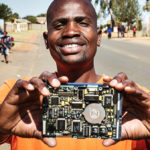Over the past 18 months, I’ve had the privilege to assist the City of Cleveland Office of Sustainability in developing a city-wide Climate Action Plan (CAP). This scope of this plan is not limited to the city’s own operations, although there is a plan for that as well, but instead looks at the entire carbon and environmental footprint for the whole city, it’s inhabitants, businesses, everything!
It goes without saying that this in an enormous undertaking that very few cities have even tried. My biggest take-away from participating in and observing the process is the importance of broad stakeholder engagement when working to improve environmental sustainability. And that thought resonates when I consider the success factors for the programs that I have been a part of in private industry. The team working on the CAP included 50 individuals with sustainability expertise representing government, private companies, and community organizations in the greater Cleveland region.
Since joining Cisco three years ago, my job has been to reduce the climate impact of Cisco’s internal operations. We achieved our 2012 carbon reduction goals of 25% and are now gearing up for our 2017 goal of 40% reduction (for a 2007 baseline). As a resident of Cleveland, I was excited to take my experiences at Cisco and volunteer my time and expertise to Cleveland’s project.
So why is it important to cast a wide net when engaging stakeholders?
Sustainability impacts everything – and everything impacts sustainability
In sustainability, every single action has such a ripple effect across a wide range of disciplines. And the best way to uncover the unintended consequences, both positive and negative, is to bring together a diverse set of people who are able to visualize the impact through their personal lens. Although we can try to consider all sides of a problem and can employ brainstorming and ideation tools to help us expand our thinking, nothing can replace having people with differing opinions bringing their personal experience and belief systems to the conversation.

One of the best examples from our conversations on the Cleveland CAP is the connection to public health. The obvious and perhaps most talked-about impact is the effect of pollution on health. But during the discussion, the impact of a significant increase in bicycle lanes on public health became apparent. Getting Clevelanders out of their cars and commuting using bicycles was proposed to reduce transportation related Greenhouse gas (GHG) emissions. However, a representative of the City’s Department of Public Health immediately gravitated to the health benefits of increased exercise. That recognition led the CAP team to discuss a series of other positive impacts like reducing traffic levels and decreasing the need for new road construction. All of these impacts are now included as benefits and scheduled to be measured in the key performance indicators of the CAP.
Engagement leads to action
We have all heard the management principle that if you want buy-in, you need to engage people in the development of the solution. Nowhere is that more true than is a sustainability plan with the scope of an entire city. Enforcement is almost impossible and incentives only go so far to encourage behavior from a diverse community. So having a large, engaged stakeholder group who have personally aligned themselves with the solution that they have helped developed is important. These stakeholders then create alignment with their personal and professional networks

Cleveland has truly embraced the concept of stakeholder engagement. The first Sustainable Cleveland Summit in 2009 had over 700 participants, and subsequent annual summits have attracted similar levels of participation. The attendees range from all parts of the city, all socioeconomic categories, and all walks of life – from students to CEOs. By focusing on themes such as local food or alternative and renewable energy, the summit can both encourage broad thinking and narrow the ideas down to discrete next steps. The future summits will certainly provide opportunities to refine and publicize the Climate Action Plan with an even wider stakeholder group.
The summits and the CAP process have helped create a great plan – and more importantly created an engaged community ready to achieve the goals set forth in the plan.


CONNECT WITH US